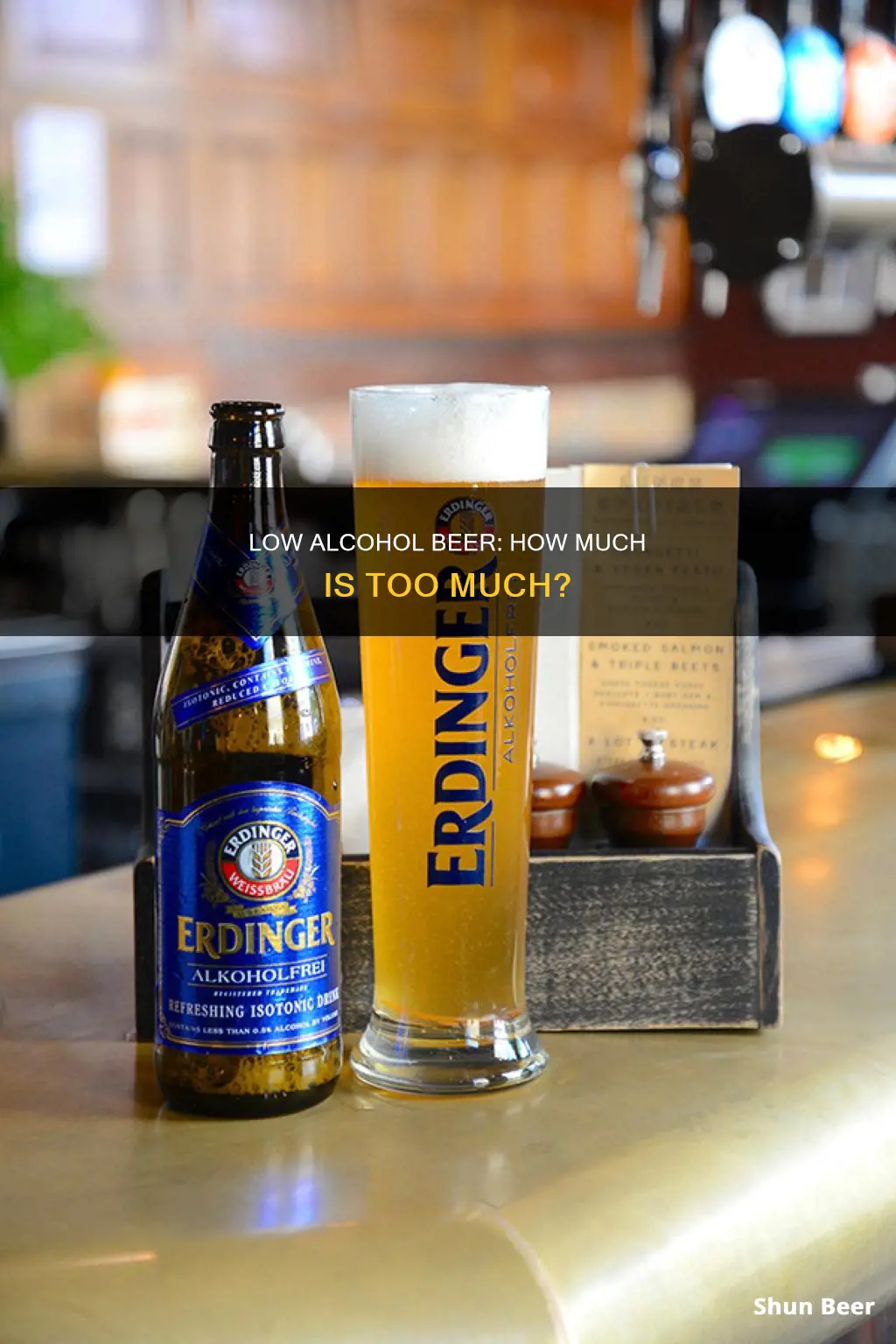
Low-alcohol beer is a popular alternative for those looking to cut down their alcohol consumption. It's designed to replicate the taste, look, and feel of standard beers, but with less alcohol. While it's a great option for some, it's important to be aware of the risks, particularly for those with alcohol problems, liver damage, or pregnant people.
In the UK, most low-alcohol beers contain 0.05% to 1.2% alcohol by volume (ABV), while in the US, non-alcoholic beers can contain up to 0.5% ABV. Despite the low alcohol content, these beers aren't suitable for those who want to avoid alcohol completely.
So, how much low-alcohol beer is too much? Well, it depends on various factors, including your body weight, metabolism, and the specific beer's ABV. However, as a general rule, your body can process a pint of 0.5% beer in around 16 minutes, making it difficult to get drunk on low-alcohol beer if you're a healthy adult.
| Characteristics | Values |
|---|---|
| Amount of alcohol | Up to 0.5% ABV |
| Calories | Fewer than alcoholic beers |
| Carbohydrates | More than alcoholic beers |
| UK licensing laws | No licence needed to sell drinks up to 0.5% ABV |
| UK drink-driving limit | 0.08% BAC |
| UK drink-driving limit (Scotland) | 0.05% BAC |
| UK Chief Medical Officers' low-risk drinking guidelines | No more than 14 units a week |
What You'll Learn

How much low-alcohol beer can you drink and still drive?
It is important to note that drinking low-alcohol beer is not the same as drinking non-alcoholic beer. The alcohol in beer comes from the fermentation of malted barley, and since alcohol is not produced in non-alcoholic beers, there is no alcohol present. This means that you can drink non-alcoholic beers without worrying about getting drunk or impairing your ability to drive.
However, low-alcohol beers typically have an alcohol content of up to 0.5% ABV. In most places, the legal alcohol limit for driving is a 0.08 blood alcohol concentration (BAC). This means that if your BAC is 0.08 or higher, you are considered legally impaired and should not be driving.
The number of low-alcohol beers a person can drink and still drive varies depending on several factors, including their weight, body type, age, sex, metabolism, and whether they have consumed any food with the drink. For example, a 180-lb man may be able to drink 3.5 regular 12-ounce beers in one hour and keep his BAC under the legal limit of 0.08%. On the other hand, a 140-lb woman may only be able to consume 2.5 regular beers in an hour and maintain a BAC of less than 0.08%.
It is important to remember that these numbers are just general estimates and do not take into account all the factors that can affect BAC. Additionally, low-alcohol beers with a higher ABV or craft beers with a higher ABV will contain a significantly higher amount of alcohol, which will impact how much a person can consume and still drive legally.
To be safe, it is always best to avoid drinking any alcohol if you plan to drive. If you have been drinking, it is recommended to take an Uber, taxi, or public transportation instead of driving.
Beer Drinking: Heart Health Risks and Strains
You may want to see also

Is low-alcohol beer bad for your health?
Low-alcohol beer is often marketed as a healthier alternative to regular beer, and it can be, but it's important to be aware of the risks before trying it.
The Benefits
Low-alcohol beer typically contains fewer calories than regular beer, and you can drive after consuming several drinks. It also reduces the risk of alcohol-related illness and severe hangover symptoms.
The Risks
Despite the health benefits, there are some dangers associated with low-alcohol beer. Firstly, it may still contain alcohol. By law, beverages can be labelled as non-alcoholic as long as they don't exceed 0.5% alcohol by volume (ABV). However, research suggests that many low-alcoholic beers contain more alcohol than their labels indicate. This is particularly important for pregnant people to be aware of, as alcohol consumption during pregnancy can lead to fetal alcohol spectrum disorder (FASD) and other birth defects.
Another risk to consider is that the smell of low-alcohol beer may be enough to trigger cravings and a subsequent relapse among those with alcohol use disorder.
So, Is It Bad for Your Health?
While low-alcohol beer can be a healthier alternative to regular beer in some ways, it's important to remember that it's not completely free of risks. It's best to read labels carefully, be mindful of your personal health goals, and consume in moderation.
Beer and Tylenol: Safe Mix?
You may want to see also

Is low-alcohol beer suitable for pregnant women?
Low-alcohol beer is a beer that contains very little to no alcohol. It is usually produced by removing the alcohol from regular alcoholic beer. While this process removes most alcohol, small amounts may remain. For example, a non-alcoholic beer typically contains approximately one gram of alcohol, whereas a regular beer contains about 14 grams.
Now, is low-alcohol beer suitable for pregnant women? The answer is no. According to the American College of Obstetrics and Gynecology (ACOG), pregnant individuals should avoid drinking any alcohol during pregnancy to avoid the risk of fetal alcohol spectrum disorder (FASD). FASD is an umbrella term for a variety of problems that can develop if a child is exposed to alcohol in the womb. The most severe form of FASD is called fetal alcohol syndrome, characterised by facial abnormalities, stunted growth, and behavioural and mental disabilities. Although this condition is almost exclusively attributed to chronically high alcohol intake during pregnancy, no safe level of alcohol intake has been established for pregnant women.
Furthermore, research suggests that many non-alcoholic beers contain more alcohol than their labels indicate. One study found that 29% of no- or low-alcohol-content beers tested had higher alcohol levels than the labels suggested. Of the zero-alcohol beers sampled, six were found to have alcohol levels higher than one per cent. In addition, drinking non-alcoholic beer can sharply increase blood alcohol levels in certain rare instances, and cause some individuals to test positive for alcohol metabolites in their urine or breath.
Therefore, it is recommended that pregnant women avoid non-alcoholic beers since these products may still contain unsafe amounts of alcohol.
Beer and Tamiflu: Is It Safe to Mix?
You may want to see also

Can you get drunk on low-alcohol beer?
Low-alcohol beer is designed to reproduce the taste of beer while minimising the inebriating effects, carbohydrates, and calories of regular alcoholic brews. But can you get drunk on it?
There are different levels of drunkenness, and a range of factors affect how alcohol impacts a person. These include:
- Time since the person last ate
- Composition and size of the last meal
- Volume and strength of the alcohol
- Speed at which the person drinks
Generally, people start to feel the minor effects of alcohol, such as feeling relaxed and a minor impairment of reasoning and memory, when their blood alcohol content (BAC) reaches 0.04%. However, the legal alcohol limit for driving in most parts of the UK is set at 0.08%, while it is stricter in Scotland and some European countries at 0.05%.
The answer varies from person to person, but in general, it is challenging to reach a drunk state by consuming low-alcohol beer. This is because the body processes the alcohol in low-alcohol beer almost as quickly as a person drinks it. For instance, the average person's body can process the alcohol in a pint of 0.5% beer in around 16 minutes, compared to almost three hours for a pint of 5% beer.
To reach a BAC of 0.04%, a person would need to drink four pints or more of 0.5% beer per hour, which is beyond the physical drinking limits of most people.
Non-alcoholic beer can contain up to 0.5% ABV and is considered "alcohol-free" or "non-alcoholic" in many countries. While it is theoretically possible to get drunk on non-alcoholic beer, it is practically impossible for an adult to do so. In a 2012 study, participants drank 1.5 litres of non-alcoholic beer with a 0.4% ABV in under an hour, and the highest BAC recorded was below 0.01%.
Final thoughts
While it is challenging to get drunk on low-alcohol beer, it is not impossible. The amount of alcohol to reach drunkenness varies from person to person, and factors such as body weight, gender, and food consumption play a role. Additionally, the margin of error in labelling laws means that a 0.5% ABV beer could contain up to 1% alcohol. Therefore, while low-alcohol beer is a good option for those looking to reduce their alcohol intake, it is not completely without risks.
Passover Beer: What Jews Can Drink and Avoid
You may want to see also

How is low-alcohol beer made?
Low-alcohol beer, also known as light beer, non-alcoholic beer, small beer, small ale, or near-beer, contains little to no alcohol by volume. It aims to reproduce the taste of beer while reducing the inebriating effects, carbohydrates, and calories of regular alcoholic brews.
Low-alcohol beers can come in various styles, including lagers, stouts, and ales, and their production often involves removing alcohol from regular beer. Here is a detailed overview of the process of making low-alcohol beer:
Brewing
The first step in brewing low-alcohol beer is to create a mash by "mashing" malted barley with hot water. This process extracts the sugars from the barley, creating a sugary liquid called wort. The wort is then boiled with hops, which adds flavour, colour, and aroma to the brew.
Fermentation
After boiling, the wort undergoes fermentation, where yeast is added to the mixture. The yeast consumes the sugars in the wort and converts them into alcohol and carbon dioxide, along with other by-products that contribute to the flavour of the beer.
Alcohol Removal
To create a low-alcohol beer, the alcohol content must be reduced. This is typically done by heating the fermented beer, as alcohol has a lower boiling point than water. However, heating can affect the flavour of the beer. To mitigate this, brewers may use vacuum distillation, which lowers the boiling point of alcohol, preserving other volatile flavour compounds.
Another method is reverse osmosis, where the beer is forced through a fine filter that only allows water, alcohol, and some volatile acids to pass through. The alcohol is then separated from the water through distillation, and the remaining water and acids are added back to the concentrated syrup.
Carbonation
After alcohol removal, the beer is flat and lacks carbonation. To address this, carbon dioxide is injected into the beer, a process similar to what is done with soda.
Final Steps
Sugar is often added to low-alcohol beer to enhance its flavour. Additionally, some manufacturers may use starter yeast and extra sugar in the bottles to initiate fermentation and create carbonation. However, this can increase alcohol levels and, if not done correctly, may cause the bottles to explode.
History
The history of low-alcohol beer dates back to medieval Europe, where it served as a safer alternative to polluted water and was less expensive than higher-alcohol brews. The production of non-alcoholic beers gained momentum during the Prohibition era in the United States, with breweries creating "near beers" to stay in business.
Understanding Beer Quantities: 24 Oz Beer Equals How Many Drinks?
You may want to see also
Frequently asked questions
No, low-alcohol beers are not completely alcohol-free. By law, they can contain up to 0.5% alcohol by volume (ABV) in the United States and the United Kingdom. However, some brands claim to offer 0.0% ABV.
It is almost impossible for a healthy adult to get drunk on low-alcohol beer (up to 0.5% ABV). Your body processes the alcohol in low-alcohol beer almost as quickly as you drink it. For example, it takes around 16 minutes for the average person's body to process a pint of 0.5% beer, compared to almost three hours for a pint of 5% beer.
No, pregnant women should avoid drinking low-alcohol beer. While it contains less alcohol than regular beer, low-alcohol beer may still contain more alcohol than its label claims. According to the American College of Obstetrics and Gynecology (ACOG), there is no safe level of alcohol intake during pregnancy.
Yes, you can drink low-alcohol beer before driving without fear of getting drunk or impairing your ability to drive. However, it is important to note that you can still be charged with drink driving if your behaviour on the road suggests impairment, even if your blood alcohol concentration is below the legal limit.







